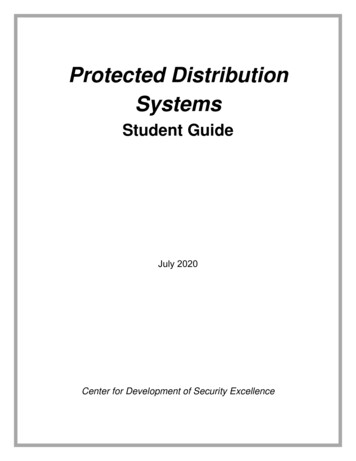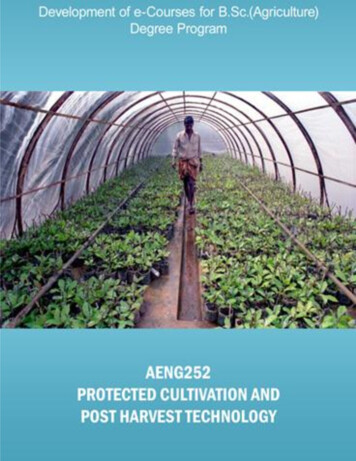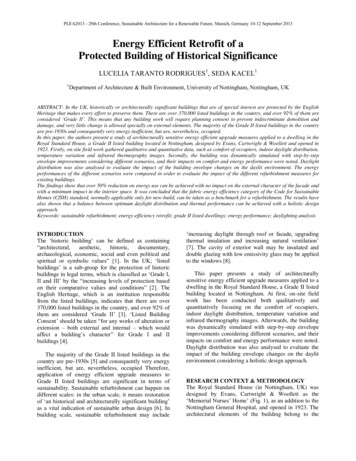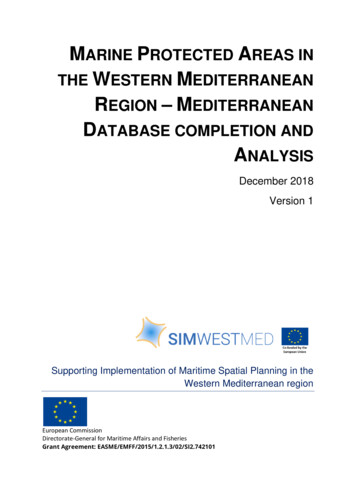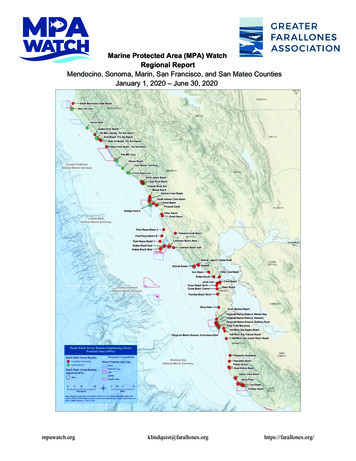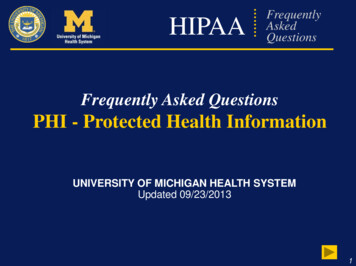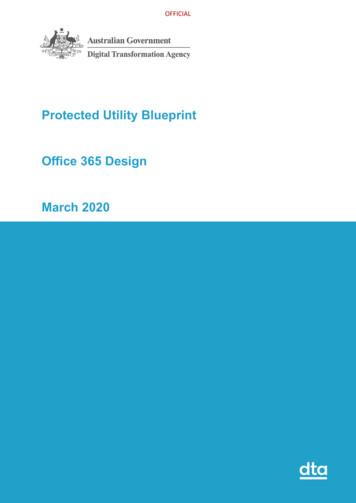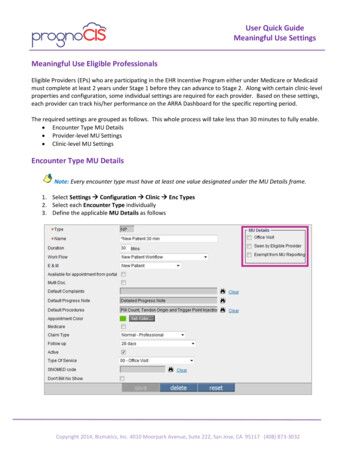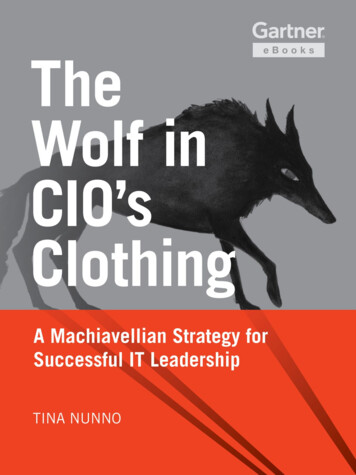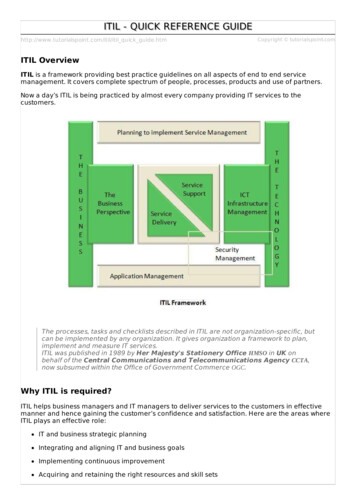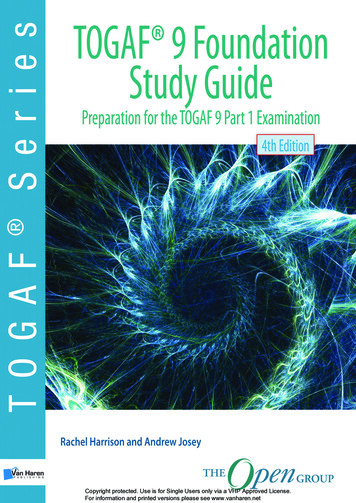
Transcription
Copyright protected. Use is for Single Users only via a VHP Approved License.For information and printed versions please see www.vanharen.net
TOGAF 9 FoundationStudy Guide 4th EditionCopyright protected. Use is for Single Users only via a VHP Approved License.For information and printed versions please see www.vanharen.net
The Open Group Publications available from Van Haren PublishingThe TOGAF Series:The TOGAF Standard, Version 9.2The TOGAF Standard, Version 9.2 – A Pocket GuideTOGAF 9 Foundation Study Guide, 4th EditionTOGAF 9 Certified Study Guide, 4th EditionThe Open Group Series:The IT4IT Reference Architecture, Version 2.1IT4IT for Managing the Business of IT – A Management GuideIT4IT Foundation Study Guide, 2nd editionThe IT4IT Reference Architecture, Version 2.1 – A Pocket GuideCloud Computing for Business – The Open Group GuideArchiMate 3.0.1 – A Pocket GuideArchiMate 2 Certification – Study GuideArchiMate 3.0.1 SpecificationThe Open Group Security Series:O-TTPS - A Management GuideOpen Information Security Management Maturity Model (O-ISM3)Open Enterprise Security Architecture (O-ESA)Risk Management – The Open Group GuideThe Open FAIR Body of Knowledge – A Pocket GuideAll titles are available to purchase from:www.opengroup.orgwww.vanharen.netand also many international and online distributors.Copyright protected. Use is for Single Users only via a VHP Approved License.For information and printed versions please see www.vanharen.net
TOGAF 9Foundation Study Guide4th EditionPreparation for the TOGAF 9 Part 1 ExaminationPrepared by Rachel Harrison of Oxford Brookes University andAndrew Josey, The Open GroupCopyright protected. Use is for Single Users only via a VHP Approved License.For information and printed versions please see www.vanharen.net
Title: TOGAF Version 9 FoundationStudy Guide 4th EditionSubtitle:Preparation for the TOGAF 9 Part 1 ExaminationSeries:TOGAF SeriesA Publication of:The Open GroupAuthor:Prof. Rachel Harrison and Andrew JoseyPublisher:Van Haren Publishing, Zaltbommel, www.vanharen.netISBN Hard copy:978 94 018 0289 5ISBN eBook (pdf)978 94 018 0290 1ISBN ePUB:978 94 018 0291 8Edition:Fourth edition, first impression, April 2018Coco Bookmedia, Amersfoort –NLLayout and Cover design:Wilco, Amersfoort – NLPrint:Copyright 2009-2018, The Open GroupAll rights reserved.No part of this publication may be reproduced, stored in a retrieval system, ortransmitted, in any form or by any means, electronic, mechanical, photocopying,recording, or otherwise, without the prior permission of the copyright owner.The views expressed in this document are not necessarily those of any particular memberof The Open Group.In the event of any discrepancy between text in this document and the official TOGAFdocumentation, the TOGAF documentation remains the authoritative versionfor certification, testing by examination, and other purposes. The official TOGAFdocumentation can be obtained online at www.opengroup.org/togaf.Study GuideTOGAF 9 Foundation, 4th EditionDocument Number: B180Published by The Open Group, April 2018.Comments relating to the material contained in this document may be submitted to:The Open GroupApex PlazaReadingBerkshire, RG1 1AXUnited Kingdomor by electronic mail to:ogspecs@opengroup.orgCopyright protected. Use is for Single Users only via a VHP Approved License.For information and printed versions please see www.vanharen.net
ContentsChapter 1 Introduction. 11.1 Key Learning Points.11.2 The Open Group Certification for People Program.11.2.1 Certification Document Structure.31.2.2 Program Vision and Principles.41.2.3 TOGAF 9 Foundation.41.2.4 The Certification Process.51.2.5 Preparing for the Examination.71.3 Summary.71.4 Test Yourself Questions.81.5 Recommended Reading.9Chapter 2 Basic Concepts.112.1 Key Learning Points.112.2 Introduction to the TOGAF 9 Standard.112.2.1 What is the TOGAF Standard?.112.2.2 Structure of the TOGAF Documentation.122.3 What is an Enterprise?.142.4 What is Architecture in the Context of the TOGAF Standard?.152.5 Why do I Need Enterprise Architecture?.162.6 What is an Architecture Framework?.182.7 Why do I Need a Framework for Enterprise Architecture?.182.8 Why is the TOGAF Standard Suitable as a Framework forEnterprise Architecture?.192.9 What are the Different Architecture Domains that the TOGAFStandard deals with?.192.10 What does the TOGAF Standard Contain?.202.10.1 The Architecture Development Method (ADM).222.10.2 ADM Guidelines and Techniques.222.10.3 Architecture Content Framework.232.10.4 The Enterprise Continuum.232.10.5 TOGAF Reference Models.232.10.6 The Architecture Capability Framework.242.11 Summary.242.12 Test Yourself Questions.252.13 Recommended Reading.26Copyright protected. Use is for Single Users only via a VHP Approved License.For information and printed versions please see www.vanharen.net
VIChapter 3 Core Concepts. 273.1 Key Learning Points.273.2 What are the Phases of the ADM?.273.3 Deliverables, Artifacts, and Building Blocks.293.4 The Enterprise Continuum.313.5 The Architecture Repository.323.6 Establishing and Maintaining an Enterprise ArchitectureCapability.343.7 Establishing an Operational Architecture Capability.353.8 Using the TOGAF Framework with Other Frameworks.363.9 Summary.383.10 Test Yourself Questions.383.11 Recommended Reading.40Chapter 4 Key Terminology. 414.1 Key Learning Points.414.2 Key Terms.414.3 Summary.534.4 Test Yourself Questions.534.5 Recommended Reading.55Chapter 5 Introduction to the Architecture Development Method. 575.1 Key Learning Points.575.2 The Architecture Development Cycle.575.3 What is the Relationship of the ADM to Other Parts of theTOGAF Standard?.625.3.1 Relationship to the Enterprise Continuum andArchitecture Repository.625.3.2 The ADM and the Foundation Architecture.635.3.3 The ADM and Supporting Guidelines and Techniques.635.4 Key Points of the ADM Cycle.645.5 How to Adapt the ADM to your Enterprise.655.6 The Need for Architecture Governance.665.7 Scoping the Architecture Activity for your Organization.675.8 Integrating the Architecture Domains for your Organization.695.9 Summary.705.10 Test Yourself Questions.705.11 Recommended Reading.72Copyright protected. Use is for Single Users only via a VHP Approved License.For information and printed versions please see www.vanharen.net
VIIChapter 6 The Enterprise Continuum and Tools. 736.1 Key Learning Points.736.2 Overview of the Enterprise Continuum.746.3 The Enterprise Continuum and Architecture Re-Use.746.4 The Constituent Parts of the Enterprise Continuum.756.4.1 The Enterprise Continuum.756.4.2 The Architecture Continuum.766.4.3 The Solutions Continuum.766.5 The Architecture Continuum in Detail.776.5.1 Foundation Architecture.786.5.2 Common Systems Architectures.786.5.3 Industry Architectures.786.5.4 Organization-Specific Architectures.796.6 The Solutions Continuum in Detail.796.6.1 Foundation Solutions.806.6.2 Common Systems Solutions.806.6.3 Industry Solutions.816.6.4 Organization-Specific Solutions.816.6.5 The Relationship of the Architecture Continuum to theSolutions Continuum.826.7 Using the Enterprise Continuum within the ADM.836.8 The Architecture Repository.836.8.1 The Architecture Landscape.856.8.2 The Standards Information Base.866.9 Tools Standardization.866.10 Summary.866.11 Test Yourself Questions.876.12 Recommended Reading.90Chapter 7 The ADM Phases. 917.1 Key Learning Points.917.2 Preliminary Phase.917.2.1 Objectives.917.2.2 Approach.927.3 Phase A: Architecture Vision.967.3.1 Objectives.967.3.2 Approach.96Copyright protected. Use is for Single Users only via a VHP Approved License.For information and printed versions please see www.vanharen.net
VIII7.47.57.67.77.87.97.107.117.127.137.14Phase B: Business Architecture.987.4.1 Objectives.987.4.2 Approach.99Phase C: Information Systems Architectures.1017.5.1 Objectives.1027.5.2 Approach.102Phase D: Technology Architecture.1057.6.1 Objectives.1057.6.2 Approach.105Phase E: Opportunities and Solutions.1077.7.1 Objectives.1077.7.2 Approach.108Phase F: Migration Planning.1097.8.1 Objectives.1097.8.2 Approach.109Phase G: Implementation Governance.1107.9.1 Objectives.1107.9.2 Approach.110Phase H: Architecture Change Management.1117.10.1 Objectives.1127.10.2 Approach.112Requirements Management.1157.11.1 Objectives.1157.11.2 Approach.115Summary.116Test Yourself Questions.117Recommended Reading.120Chapter 8 ADM Guidelines and Techniques.1218.1 Key Learning Points.1218.2 ADM Guidelines and Techniques Overview.1218.3 Using the TOGAF ADM in the Context of a SpecificArchitectural Style.1228.4 Architecture Principles.1248.4.1 The TOGAF Template for Defining ArchitecturePrinciples.1258.4.2 What Makes a Good Architecture Principle?.126Copyright protected. Use is for Single Users only via a VHP Approved License.For information and printed versions please see www.vanharen.net
IX8.58.68.78.88.98.108.118.128.13Business Scenarios.1278.5.1 What is a Business Scenario?.1278.5.2 The Use of Business Scenarios in the ADM.128Gap Analysis.129Interoperability.1318.7.1 Interoperability and the ADM.133Business Transformation Readiness Assessment.134Risk Management.1358.9.1 Risk Management in the ADM.135Capability-Based Planning.136Summary.136Test Yourself Questions.137Recommended Reading.139Chapter 9 Architecture Governance.1419.1 Key Learning Points.1419.2 Introduction to Architecture Governance.1429.3 TOGAF Architecture Governance Framework.1439.3.1 Conceptual Structure.1449.3.2 Organizational Structure.1459.4 The Benefits of Architecture Governance.1459.5 Architecture Board.1469.6 Architecture Contracts.1479.7 Architecture Compliance.1489.7.1 The Meaning of Architecture Compliance.1489.7.2 The Need for Architecture Compliance.1499.7.3 The Purpose of Architecture Compliance Reviews.1499.7.4 The Architecture Compliance Review Process.1509.8 Using the ADM to Establish an Architecture Capability.1529.9 Summary.1539.10 Test Yourself Questions.1549.11 Recommended Reading.157Chapter 10 Architecture Views, Architecture Viewpoints, andStakeholders 15910.1 Key Learning Points.15910.2 Concepts and Definitions.15910.2.1 System.160Copyright protected. Use is for Single Users only via a VHP Approved License.For information and printed versions please see www.vanharen.net
X10.2.2 Stakeholders.16010.2.3 Concerns.16110.2.4 Architecture View.16110.2.5 Architecture Viewpoint.16210.3 Architecture Views and Viewpoints.16210.4 The Relationship between Stakeholders, Concerns, Views, andViewpoints.16510.5 The Architecture View Creation Process.16610.6 Summary.16710.7 Test Yourself Questions.16810.8 Recommended Reading.169Chapter 11 Building Blocks. 17111.1 Key Learning Points.17111.2 What is a Building Block?.17111.3 Architecture Building Blocks and Solution Building Blocks.17211.3.1 Architecture Building Blocks.17311.3.2 Solution Building Blocks.17311.4 Building Blocks and the ADM.17411.5 Architecture Patterns.17511.6 Summary.17611.7 Test Yourself Questions.17611.8 Recommended Reading.177Chapter 12 ADM Deliverables.17912.1 Key Learning Points.17912.2 The Role of Architecture Deliverables.17912.3 The Purpose of Key Deliverables.18012.3.1 Architecture Building Blocks (ABBs).18012.3.2 Architecture Contract.18012.3.3 Architecture Definition Document.18112.3.4 Architecture Principles.18112.3.5 Architecture Repository.18212.3.6 Architecture Requirements Specification.18212.3.7 Architecture Roadmap.18212.3.8 Architecture Vision.18212.3.9 Business Principles, Business Goals, and BusinessDrivers.183Copyright protected. Use is for Single Users only via a VHP Approved License.For information and printed versions please see www.vanharen.net
XI12.3.10 Capability Assessment.18312.3.11 Change Request.18412.3.12 Communications Plan.18412.3.13 Compliance Assessment.18412.3.14 Implementation and Migration Plan.18412.3.15 Implementation Governance Model.18512.3.16 Organizational Model for Enterprise Architecture.18512.3.17 Request for Architecture Work.18512.3.18 Requirements Impact Assessment.18612.3.19 Solution Building Blocks.18612.3.20 Statement of Architecture Work.18612.3.21 Tailored Architecture Framework.18612.4 Summary.18712.5 Test Yourself Questions.18712.6 Recommended Reading.188Chapter 13 TOGAF Reference Models. 18913.1 Key Learning Points.18913.2 The TOGAF TRM as a Foundation Architecture.18913.3 The Integrated Information Infrastructure Reference Model.19213.4 Boundaryless Information Flow.19313.5 Summary.19613.6 Test Yourself Questions.19713.7 Recommended Reading.198Appendix A Answers to Test Yourself Questions. 199A.1 Answers to the Test Yourself Questions.199Appendix B Test Yourself Examination Papers. 205B.1 Examination Papers.205B.2 Test Yourself Examination Paper 1.205B.3 Test Yourself Examination Paper 2.218Appendix C Test Yourself Examination Paper Answers. 231C.1 Scoring the Examinations.231C.2 Answers to Test Yourself Examination Paper 1.231C.3 Answers to Test Yourself Examination Paper 2.237Copyright protected. Use is for Single Users only via a VHP Approved License.For information and printed versions please see www.vanharen.net
XIIAppendix D TOGAF 9 Foundation Syllabus. 245D.1 Basic Concepts.245D.2 Core Concepts.246D.3 General Definitions.246D.4 Introduction to the ADM.248D.5 Enterprise Continuum and Tools.249D.6 ADM Phases (Level 1).250D.7 ADM Guidelines and Techniques.252D.8 Architecture Governance (Level 1).253D.9 Architecture Views, Viewpoints, and Stakeholders.254D.10 Building Blocks.254D.11 ADM Deliverables.255D.12 TOGAF Reference Models (Level 1).256D.13 TOGAF Certification Program.256Index. 257Copyright protected. Use is for Single Users only via a VHP Approved License.For information and printed versions please see www.vanharen.net
XIIIPrefaceThis DocumentThis document is a Study Guide for the TOGAF 9 Foundation qualification.This fourth edition is based on Version 3 of The Open Group Certificationfor People: Conformance Requirements (Multi-Level), and is aligned with theTOGAF Standard, Version 9.2.It gives an overview of every learning objective for the TOGAF 9 FoundationSyllabus and in-depth covera
Title: TOGAF Version 9 Foundation Study Guide 4th Edition Subtitle: Preparation for the TOGAF 9 Part 1 Examination Series: TOGAF Series A Publication of: The Open Group Author: Prof. Rachel Harrison and Andrew Josey Publisher: Van Haren Publishing, Zaltbommel, www.vanharen.net ISBN Hard copy: 978 94 018 0

